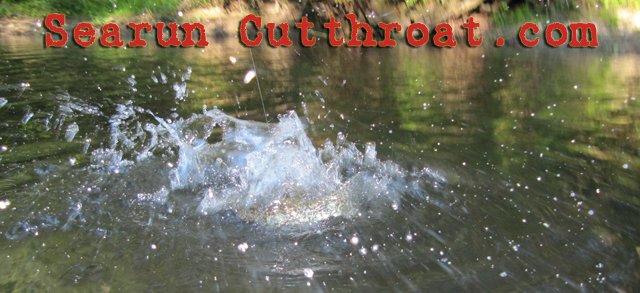
Searun Cutthroat Trout.
Oncorhynchus clarki clarki. To many anglers, the names Searun Cutthroat, Harvest Trout, Coastal Cutthroat, and Blueback stir fantasies of crushing takedowns, fly lines coming tight, strong runs and aerial acrobatics. The Searun Cutthroat trout is one of the Pacific Northwest’s true treasures.
So what is a searun cutthroat?
 Searun cutthroat, also know as coastal cutthroat, harvest trout, and bluebacks are a unique and distinguished strain of cutthroat trout. The only of the 13 strains that migrates out to saltwater to feed before making the long journey back upstream to spawn, they are a unique and treasured fish along the coast.
Searun cutthroat, also know as coastal cutthroat, harvest trout, and bluebacks are a unique and distinguished strain of cutthroat trout. The only of the 13 strains that migrates out to saltwater to feed before making the long journey back upstream to spawn, they are a unique and treasured fish along the coast.
Born in the upper watershed of rivers in small tributaries, searun cutthroat trout are ill equipped to compete against more powerful steelhead, coho, and other salmon smolt. This is one of the reasons why the adult coastal cutthroat spawn in the upper reaches, away from competing spawners. Newly hatched smolt hide in the slack waters created by downed trees and overhanging brush.
After birth, searun cutthroat generally spend between one and two years in freshwater feeding on nymphs, insects, and anything smaller than them. As voracious feeders, they will track down and eat everything they can.
Into the Salt…
 Unlike steelhead and salmon, after the journey downstream, searun cutthroat don’t tend to wander far from their spawning rivers and streams. They usually prefer to stay close, within a few miles, of the river they migrated from. The next year or two of their life is spent gorging on crustaceans, shrimp, sandlance, and other prey.
Unlike steelhead and salmon, after the journey downstream, searun cutthroat don’t tend to wander far from their spawning rivers and streams. They usually prefer to stay close, within a few miles, of the river they migrated from. The next year or two of their life is spent gorging on crustaceans, shrimp, sandlance, and other prey.
Searun cutthroat tend to feed in tidal areas with significant rips, or flows. They use natural obstructions like rocks, points of land, and kelp beds for protection and to hide behind before ambushing their prey. Fishing around these areas at times of tidal movement can be productive.
Generally a floating line will suffice when chasing searun cutthroat in the sound, but sometimes an intermediate or sink tip will be the ticket.
Fly patterns vary but usually baitfish flies or shrimp patterns will cover most situations. Sometimes a waking pattern can produce surface action which can be extremely exciting.
The Journey back upriver…
 Searun cutthroat get the urge to head back upriver in the early fall, and start to make their way upstream. They spend a few months making their way back up river and generally spawn in the winter and spring.
Searun cutthroat get the urge to head back upriver in the early fall, and start to make their way upstream. They spend a few months making their way back up river and generally spawn in the winter and spring.
Coastal cutthroat can be caught in the rivers and creeks they migrate back up, and are usually found hiding around obstacles like downed trees, rocks, and at stream mouths. Popular flies are spiders, reverse spiders, muddlers, and more traditional patterns like the borden special and polar shrimp.
After heading into the upper reaches of the rivers and streams to spawn, the cycle begins anew.
Searun Cutthroat are a Great Fishing Opportunity.
Searun cutthroat have been making a comeback in the Pacific Northwest. While still listed as endangered, their numbers have been climbing and creating a viable fishery. All searun cutthroat must be released when caught in saltwater. Once entering the rivers they lose their protection slightly as they fall under the rivers general trout rules.
When targeting searun cutthroat it is advised to use single barbless hooks and to treat them with the utmost respect. Remove them from the water only briefly before release and use a soft knotless landing net when possible.